Displaying items by tag: World War II
#tallship – With St Patrick's Day almost upon us, the westward trek across the Atlantic in search of American benevolence and funding for worthy objectives can become a very crowded pilgrimage. Among those looking for meaningful support for their pet projects, there will likely be proponents of some sort of new Tall Ship to replace the much-mourned brigantine Asgard II, and the ketch Lord Rank, both of which foundered in 2008 to leave Ireland - north and south alike - bereft of national sail training vessels.
Since then, there have been re-groupings of those who support the admirable concept of sail training for young people. In all, there may be as many as five different bodies on the island of Ireland which now provide access to the international programme. Coiste an Asgard itself was wound up in 2011, but it was immediately re-born as the Dublin-headquartered Sail Training Ireland, the national authority which carries the imprimatur of Sail Training International, the global body which co-ordinates and regulates all sail training.
The other main organisation, often functioning in tandem with Sail Training Ireland, is the Atlantic Youth Trust. It has offices in both Dun Laoghaire and Belfast, and has as its primary objective the construction and commissioning – for all Ireland – of a Class A 40-metre three-masted barquentine. WM Nixon continues with the story.
When we carried a history and analysis of Ireland's involvement with the International Tall Ship and Sail Training movement on this site on January 17th, the immediate response was formidable, and in favour. It continues to register hits at a rate which shows that the maritime community in Ireland has a real wish to see our own proper tall ship.
To achieve this ambition, in terms of having a clearly outlined plan the Atlantic Youth Trust is way ahead. With leading personnel from many parts of Ireland on its high-powered board of Trustees and Directors, the concept - originally inspired by Enda O'Coineen and John Killeen of Galway – is already becoming very complete.
Executive Director Neil O'Hagan and other have researched globally in order to analyse the success of more than two dozen national sail training schemes, and they have concluded that the best model to learn from is the Spirit of Adventure Trust in New Zealand, which functions through training based around the barquentine Spirit of New Zealand, which at 45.2 metres in "sparred length" is steel built registering at 184 gross tons, and carries 40 trainees.
The funding concept on the capital outlay for building the new ship for Ireland will ultimately rely on a total of €15 million being put up jointly by the two governments in the interests of inter-community and cross-border co-operation. Although the current turmoil in the Northern Ireland political administration might temporarily impair the onward progress of the plan, it seems to have a certain inevitable momentum, and highly-regarded Netherlands-based Dykstra Naval Architects have been retained on the project, as have their associates at Damen Shipyards, who may supply the vessel in flatpack form for final construction in Ireland.
As to running costs, the AYT point out that it will come out of current spending, as the vessel by nature of its work will be able to tap into government funds for social welfare and other youth schemes.
Faced with such a juggernaut of ideas, energy, contacts at top government level, and sheer enthusiasm, it seems churlish to question the validity of what is, after all is said and done, a magnificent project. But there are many in Irish sailing in general and sail training in particular who are concerned about the thinking on which it is all based.
To begin with, while we all admire the maritime spirit of New Zealand, does it make sense to draw conclusions for Ireland from a successful scheme in what is essentially a very isolated island nation? Ireland may be an island nation, but it's clearly wide of the mark to describe us as isolated, and this is reflected in the pattern of tall ships visit. If just six tall ships turn up at one port in New Zealand, it's regarded as a major event. But if less than sixty tall ships turn up at this year's Tall Ships Festival in Belfast at the beginning of July, then it will be regarded as a non-event.
In other words, Spirit of New Zealand usually functions in relative isolation, so it is not sail training as we know it in Europe. In fact, she is more of a floating school cum boot camp which happens to set sails, and in order to keep her very numerous trainee complement of 40 busy, while cruising in New Zealand waters (which she does nearly all the time), she is escorted by a large rib which frequently conveys the trainees ashore for land-bound ventures which sometimes out-balance their sea time.
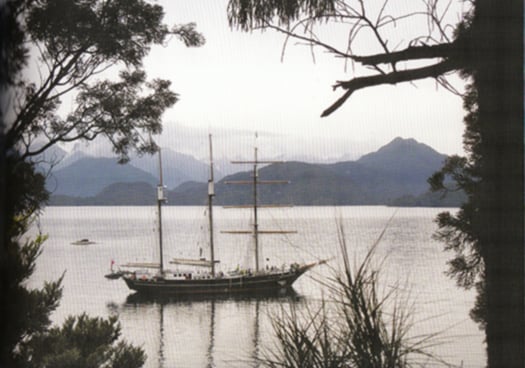
Alone, all alone.....the Spirit of New Zealand in a remote inlet on New Zealand's South Island. With forty trainees and a relatively easily-handled rig, she has a programme whch includes much shoreside activity. Photo courtesy STI
It's a very attractive programme in the New Zealand context, as they have many remote coastal areas which are virtually uninhabited and ripe for shore adventures which will not conflict with the rights of local inhabitants. But in Ireland and much of Europe such a programme would immediately meet problems, and for Ireland it makes more sense to follow the European pattern which puts an almost total emphasis on voyaging and sail training races.
Were a heavily-crewed vessel such as Spirit of New Zealand to do the European programme, there simply wouldn't be enough work for the 20 trainees on each watch to keep them happily occupied for long periods. Ideally, trainee tall ships are extremely labour-intensive for all hands, and in Europe that's the way it is done, but it needs what amounts to individual attention for each trainee.
So it's difficult to escape the conclusion that one reason for the attraction of the New Zealand scheme for the Atlantic Youth Trust is that it wins out in the numbers game. Forty young people taken out of troubled and aimless environments ashore, and sent away together on a voyage, is an impressive amount of social problems temporarily sorted in one fell swoop.
But will it be as behaviourally beneficial, in the long term, as it would be for a smaller number of people on a smaller and busier vessel? It will vary from case to case, but generally you'd reckon that the smaller more personal crew setup, with each trainee more directly involved in the sailing of the ship, would produce better results, while always remember that having as much square rig as possible is central to the concept.
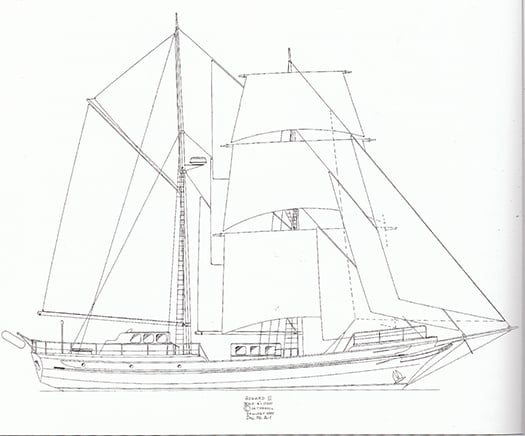
A timeless design which remains a very viable proposition for an easily managed ship which keeps her crew busy. Jack Tyrell's lines for Asgard II would lend themselves to construction in steel or even aluminium.
Ideally, to see Ireland's Tall Ship-owning reputation restored, many of us would like to see not just one newly-built replica of the 84ft brigantine Asgard II being launched, but three – one each for Cork, Dublin and Belfast. For, at the moment, the main axis of Atlantic Youth Trust activity seems to be between Dublin and Belfast. Yet as last weekend's National Annual Sailing Awards ceremony in Dublin so clearly underlined, Cork is really where it's at in terms of maritime development, and the lack of a significant Cork element seems to be a weakness of the AYT scheme.
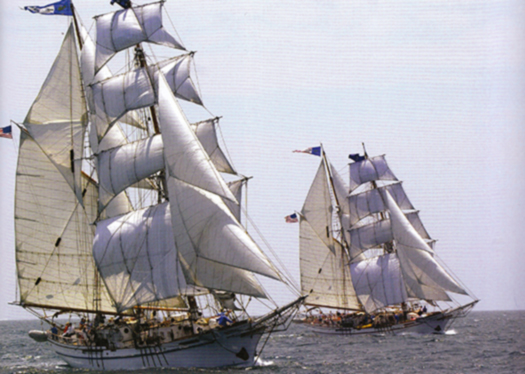
Might this be the way forward? One of our suggestions today is that Ireland really needs three Asgard IIs, based in Cork, Dublin and Belfast. We get an idea of how it might look with the two sister-ship American brigantines Exy Johnson and Irving Johnson, which are based in Los Angeles in California, where they were built in 2002.
Nevertheless, it says much for the dedication and energy of those promoting the Atlantic Youth Trust that we have the luxury of debating the validity of their plans, which have been so thoroughly developed. We may disagree with their conclusion, but it's not total disagreement – an Irish version of Spirit of New Zealand would be a very emphatic improvement on our present ship-less state, which is too much of a reflection of an ancient and negative mind-set.
Every time you see the Tall Ships gather and see how maritime countries of population comparable to Ireland, such as Norway, Denmark and Portugal, can send forth spectacularly handsome Tall Ships, it becomes a painful reminder of how the new Irish Free State increasingly turned its back on the sea.
The fact was admitted by Minister for the Marine Simon Coveney at last week's National Sailing Awards Ceremony in a speech which hinted at some very significant developments in the Irish maritime sphere in the near future.
But really, what Minister Coveney was talking about is that it is time and more for us to grow up in our attitude to the sea. When the Free State was struggling into being in 1922, the popular view was that British power was synonymous with sea power. So if you were against the sea and seafaring in all its manifestations, then you were demonstrating the purity of your patriotism through adopting what was essentially if subconsciously an anti-British stance. Childish perhaps. But we all know that's the way it was.
So despite the flurry of maritime enthusiasm which was engendered by national emergency during World War II to inspire the creation of Irish Shipping and the Maritime Inscription, what this meant was that when the underlying attitude genuinely began to change in the 1950s, a positive attitude towards the sea wasn't being built upwards from Ground Zero. It was being built from Ground Minus Thirty – the number of years that an anti-maritime attitude had been the unstated yet very real official policy.
Thus there was a period when Irish maritime enthusiasm had to be kept going almost as a secret cult, and I'd an odd reminder of this some weeks back at the annual Awards Ceremony of Sail Training Ireland. The Patron of STI is President Higgins, and the event was held – for the second year running – in the Mansion House in Dublin. Yet the very fact of the identity of their Patron, and of their event being staged in the Mansion House in the presence of Lord Mayor Christy Burke, provided such pleasure and pride for everyone in the gathering that it was a forceful reminder that, not so very long ago, seafaring was very much the poor relation in Ireland, and there were those in authority who would have happily air-brushed it out of the national picture entirely, leaving it to foreign crews to undertake the rough trades of the sea.
But thanks to those former members of Coiste an Asgard who refused to give up the vision of sail training for Ireland, even as the onset of economic Armageddon from 2008 to 2011 made any prospect of a new Asgard II a very distant vision as the government chucked the €3.8 million insurance payout into the bottomless pit of national debut, Sail Training Ireland arose like a Phoenix and set in place sail training bursaries for places on foreign tall ships, using international contacts built up during the 27 successful Asgard II years to ensure that Ireland could re-build our position at the heart of the movement.
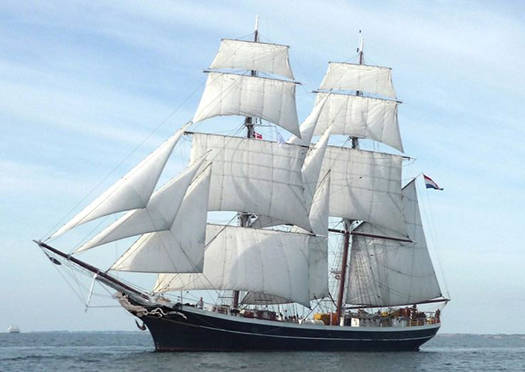
She keeps them busy....the Dutch brig Morgenster is superbly labour-intensive in the best sail training traditions. Photo courtesy STI
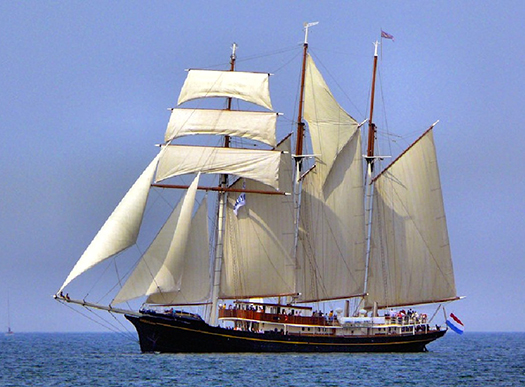
Gulden Leeuw is another of the Dutch Tall Ships which have been taking Irish trainees to sea on Sail Training International programmes. Photo: Courtesy STI
The thriving tall ships scene in the Netherlands – which has become a focal point for sail training and the Tall Ships industry for all Europe – proved the most fruitful placement area, with most Irish trainees being positioned aboard the very handsome 48 m (sparred length) brig Morgenster, which has become a familiar sight in Irish ports. Another ship well used is the three-masted topsail schooner Gulden Leeuw, a long slim craft as she is 70 m in sparred length, while that noted poster girl of Tall Ships sailing, the 56 metre three masted Dutch barque Europa, also carried Irish crew from time to time.
However, while placements on such vessels work very well, the hankering for an Irish sail training flagship is always there, and fortunately in recent years Oliver Hart's 70ft training schooner Spirit of Oysterhaven has been punching way above her weight in filling the role in gallant style with a varied programme on the Irish coast.
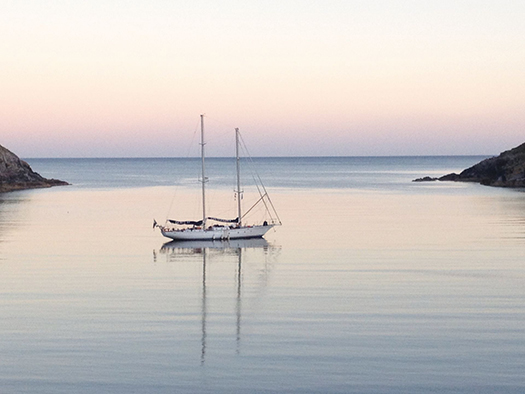
Spirit of Oysterhaven in South Harbour, Cape Clear Photo: Oliver Hart
This and much more was reflected in the Sail Training Ireland Awards Ceremony in the Mansion House, a goodly gathering which was representative not just of every possible aspect of sail training at home and abroad, but also of Irish ports which are increasingly interested in an activity which brings their ancient waterfronts vividly to life. And the progress of various ship projects was spoken for by everything from complete vessels such as the Basque Spanish schooner Atyla represented by Rodrigo de la Serna, through vessels in the making as personified by our own ketch Ilen. She has since seen her final new plank knocked ceremonially into place at Oldcourt in Baltimore, but here's an evocative video Gary MacMahon left with us of the creative planking process under way. And present too was Neil O'Hagan of Atlantic Youth Trust, whose organisation deservedly received recognition for their pioneering work towards a completely new ship.
{youtube}ZLT3D8TBbwk{/youtube}
The main awards presented in the Mansion House by STI Chairman Seamus McLoughlin, who is former Head of Operations for Dublin Port, were:
1. Trainee of the year: Andrew Crowley
2. Special Contribution Award: Turlough Kennedy
3. Special Achievement Award: Fiona Armson
4. Perpetual Asgard Award: For an outstanding contribution to, or achievement in Sail Training by an individual or group: Atlantic Youth Trust / Foroige Group of Trainees
5. Watch-leader of the Year: Sara Mason
6. Volunteer of the year: Jonathan O'Brien
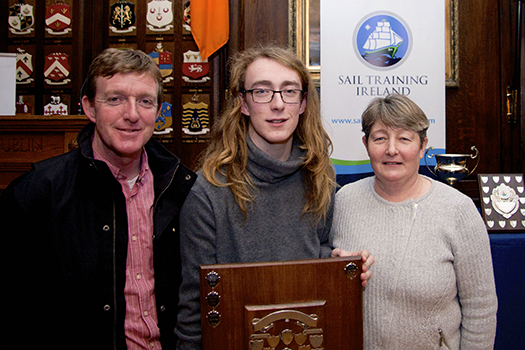
Trainee of the Year Andrew Crowley with his parents in the Mansion House
Trainee of the Year Award: Andrew Crowley
Andrew is Club Captain of the Spirit of Oysterhaven Trust. During 2014, he was instrumental in helping to organise the Club's sailing trips aboard Spirit of Oysterhaven with a special emphasis on providing opportunities for young people with disability. He helped to organise the Club's Youth in Action programme, and crewed aboard Spirit during the Irish Cruising Club's sponsored Anniversary voyage from Glandore to Glengariff with a crew of eight trainees, including several with disability. During the summer Andrew was a vital member of a short-handed crew delivering Spirit from Oysterhaven to Glandore during which he proved himself an outstanding active crew member.
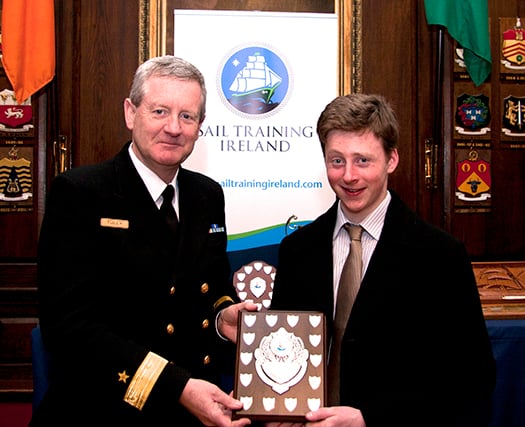
Commodore Hugh Tully, Flag Officer Commanding Naval Service, with Turlough Kennedy, who received the Special Contribution Award
Special Contribution Award: Turlough Kennedy
This year's special contribution award goes to Turlough Kennedy from the lakeside port of Scarriff in County Clare for the outstanding role he filled on the Dutch tall ship Morgenster.
To quote Michael Byrne, Director of Sail Training Ireland: "This contribution was not only recognised by us. On completion of last year's voyage Turlough - despite his limited sea going experience - was offered a crew member's berth on board the ship by the Captain. While he was not in a position last year to take up this offer for the remainder of the 2014 season, in 2015 we are delighted that Turlough will be sailing as voluntary crew on board the Morgenster. The following is a short note from the ship's Captain, Harry Muter: "Turlough sailed with us last year and he was very good good both in the sailing department as in the social processes. For his age he was surprisingly adult, patient and emphatic. And then the music, it coloured this voyage, and Turlough played a role with his complicated bagpipe and improvisation talent. Looking forward to sail with him again." " (There are no prizes for guessing that "complicated bagpipes" are Uileann Pipes).
Special Achievement Award: Fiona Armson
The special achievement award this year went to Fiona Armson for the tenacity and determination she showed by completing her 14 day voyage. Fiona found some aspects of life at sea a real challenge but despite being given several opportunities by her leaders and the crew to take on a lighter work load Fiona refused to leave her watch and pushed on.
Fiona completed her voyage having never missed a single watch or duty and, in a way that would put a smile on any sailor's face, she sailed the Gulden Leeuw into her home port of Bangor.
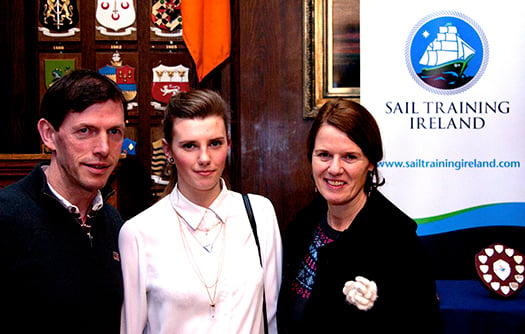
Special Achievement Award Winner Fiona Armson with her parents
Perpetual Asgard Award
Awarded to a group of four Foroige Trainees: Michael Collins, Dean Mc Keon, Brandon McDonagh, and Daniel O'Halloran,
In March 2014, four young people from Ballybane in Galway set out on a remarkable adventure, travelling half way around the world to experience the Spirit of Adventure's 10-Day Youth Development Voyage in New Zealand. Three youth workers accompanied the group for the three week trip, and one of them, Pearse O'Toole, was at the Mansion House with them. The trip was funded by a private donation and managed by the Atlantic Youth Trust and Foroige.
The group spent 10-days sailing around the magnificent Hauraki Gulf off Auckland on the barquentine Spirit of New Zealand. They adapted very well to their new surroundings as crew members and returned with fresh skills, more confidence than ever, and a new outlook on life and what is possible.
Neil O'Hagan, Executive Director of the Atlantic Youth Trust, followed this award with a presentation about the Peace and Reconciliation Fund-supported Sea-Connections scheme, and then the next award was remarkably appropriate, as it was for the Watch Leader of the Year and it went to Sara Mason for her very successful participation in an EU Youth Exchange Voyage on Gulden Leeuw.
Sara (pronounced saarah) is from the North Island of New Zealand, but now lives and studies in Dublin. She is part of the Shackleton Outdoor Adventure Management Diploma Course in Colaiste Dhulaigh in Coolock. She joined the team of youth leaders which facilitated the main voyage programme of Youth Exchange projects in May-June. As a leader on the Dutch Ship Gulden Leeuw, she cared for and facilitated a group of 40 young adults over a 14 day period. She was an outstanding support to them as a leader, and brought with her a set of skills that are unique to professionals who spend their lives working with people in the outdoor adventure industry. She also has a fantastic energy and enthusiasm and was an inspiration to the trainees and other leaders.
Volunteer of the Year Award - Jonathan O'Brien
Jonathan has become involved in a multitude of voluntary activities with Sail Training Ireland in the last year. In 2013 he volunteered as a youth leader for one of STI's youth exchange voyages for 10 days from Belfast to Dublin. In 2014 he was head-leader across youth exchange voyages with a total of 8 leaders, with at times up to 100 trainees across three ships seeking his support.
Having a background in both outdoor education and in social care, Jonathan has an exceptional set of skills that lend themselves very well to the role of leader on a tall ship, and he has now found himself "volunteered" for a position on STI's sub-committee for trainee programmes. During 2014, he also spent time on a number of ships across Europe, while somehow also fitting in a spell serving as First Mate on the Spirit of Oysterhaven. He is helping to develop on-board programmes for a number of STI's funded voyage schemes during 2015, and will also train STI's group of twelve youth leaders in April.
So the good work goes on, but the more of it there is, the more it become apparent that Ireland needs her own tall ship, and the sooner the better. A programme of international placement may work very well for those in the know, but for people down the country which are remote from maritime communities, it often takes the stimulus and sense of pride engendered by an Irish ship to make that first move afloat.
It was summed up so well by investigative academic and journalist Dr Elaine Byrne in our story about the Tall Ships on January 17th that it deserves repeating here. Usually in her line of work, Elaine Byrne takes no prisoners. But the quiet depth of feeling underlying the brief story of how the Byrne family from the deepest rural depths of County Carlow became involved in sail training has a resonance for us all today:
"I'm the oldest of seven children from a farming family on the Carlow/Wicklow border, where the household income is augmented with a funeral undertaking business attached to a pub in which I might still work on visits home. Our background is just about as far as it's possible to be from Ireland's maritime community. Yet thanks to Asgard II, I was able to take a step into the unknown world of the high seas as a trainee on board, and liked it so much that over the years I spent two months in all on board, graduating through the Watch Leader scheme and sailing in the Tall Ships programmes of races and cruises-in-company.
Down in the depths of the country, my new experiences changed the family's perceptions of seafaring. Four of my siblings then had the opportunity to sail on Asgard II. If it were not for Asgard II, my family would never have had the chance to sail, as we did not live near the sea, nor had the financial resources to do so. The Asgard II played a large role in our family life as it became a Rite of Passage to sail on board her. My two youngest siblings did not sail on Asgard II because she sank, which they much regret.
Apart from the discipline of sailing and the adventure of new experiences and countries, the Asgard II brought people of different social class and background together. There are few experiences which can achieve so much during the formative years of young adulthood".
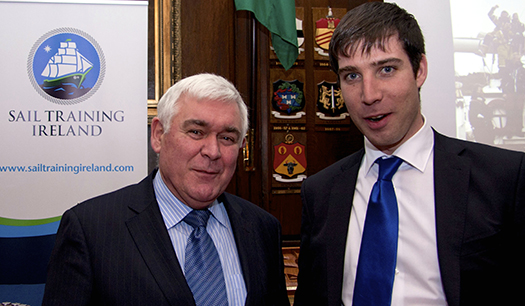
Seamus McLoughlin, Chairman of Sail Training Ireland, with Michael Byrne, Director.

Carolanna Foley, awarded a Drogheda Port Sail Training Bursary, with Seamus McLoughlin (left) and Commodore Hugh Tully
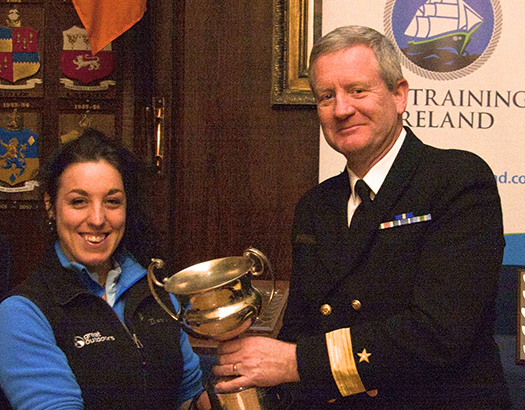
Sara Mason, Watch Leader of the Year, with Commodore Hugh Tully

Jonathan O'Brien (left) Volunteer of the Year, with Oliver Hart
- Sagres
- Tall ship
- Coiste an Asgard
- Atlantic Youth Trust
- barquentine
- Sail Training Ireland
- Sail Training International
- John Killeen
- Enda O'Coineen
- Neil O'Hagan
- Dykstra
- Damen Shipyard
- sailing
- Simon Coveney
- Lord Mayor
- Phoenix
- Spirit of Oysterhaven
- Europa
- Morgenster
- Gulden Leeuw
- Basque Spanish schooner Atyla
- Ilen
- Elaine Byrne
- Oysterhaven
- Mansion House
- Christy Burke
- World War II
#dday – More than three generations have come of age since the end of World War II. For most people nowadays, it is remote and sometimes incomprehensible history, captured only in films which - it is assumed - exaggerate the horror of it all.
It certainly suggests a world which could not be more different from that which we enjoy today. With all modern life's problems, we still have a freedom of movement and a choice of activities which were unknown for those on active service during the six years of war. Yet among those who volunteered – including many Irishmen and women – there was a clearcut feeling that a job needed to be done. But once it was done, then peacetime life could be enjoyed with extra zest.
This week, senior Dun Laoghaire sailing man Mickey d'Alton was awarded France's Legion d'Honneur and America's Distinguished Service Award in celebration and commemoration of his personal contribution to the success of D-Day in 1944. W M Nixon reflects on some very special and personal sailing stories.
You could tell there was something different about these men. From the mid 1940s onwards, there were these Irish sailing enthusiasts whose pleasure in our sport had its own special zest. They lived for the moment, they lived to sail the sea. The amount of sailing they did, and their huge enjoyment of it, was a wonder to behold.
For these were the men who had seen active service at sea in World War II from 1939 to 1945. Ireland had stayed neutral. But there were those who, while they may well have supported this policy of neutrality for Ireland, nevertheless felt the need to get personally involved in the war against Nazi Germany. Mostly, they'd joined the British army. Then there were those who sought the opportunity to learn flying while they were at it, and joined the Royal Air Force. But from within Ireland's sailing community, there were those who felt the only way to go to battle was in the war at sea.
Yet during the war itself, when they came home on leave to neutral Ireland, they went sailing whenever possible, and would bring like-minded British sailing enthusiasts with them to savour the relaxation of being able to go afloat simply for pleasure and freedom of movement, rather than for sudden sharp bursts of activity trying to kill other seafarers between the long periods of acute boredom at sea or in port waiting for action.
Until recently, despite the fact that Sweden, Switzerland and Spain stayed neutral throughout World War II without drawing obloquy upon themselves, Irish neutrality was a bone of contention even though Irish rebel forces had been at war with Britain only eighteen years earlier, and more recently there'd been Civil War in 1922 over the resulting peace treaty. Thus if Eamonn de Valera had led Ireland into World War II on either side, it would have resulted in another civil war, whereas the policy of careful neutrality, while not being totally hostile to the Allied cause against Germany, was in fact the best solution to a wellnigh intractable policy problem.
While historians may still argue about it today, a searchlight of pure common sense was shone into this sometimes murky corner in June 2014 on the 70th Anniversary of the Normandy Landings when D-Day veteran Mickey d'Alton – decorated this week with the Legion d'Honneur for his distinguished service in command of a Tank Landing Craft at Omaha Beach on June 7th 1944 - was interviewed about his experiences.
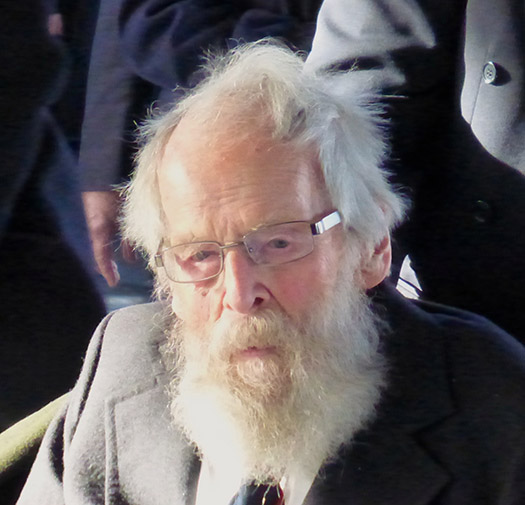 Mickey d'Alton in thoughtful mood aboard the French Naval Vessel Somme before receiving the Legion d'Honneur. Photo: W M Nixon
Mickey d'Alton in thoughtful mood aboard the French Naval Vessel Somme before receiving the Legion d'Honneur. Photo: W M Nixon
Almost as an afterthought, he was asked how he had felt - as an active combatant – about Irish neutrality. His typically clear-sighted analysis was like a breath of fresh air, a clarion call of sound reasoning. Mickey d'Alton thought that Irish neutrality had been the best possible way forward, indeed the only possible way. Apart from the very real risk of another civil war just 17 years after the previous one had ended with much bloodshed, if the government had decided to enter the new war, had they done so on the German side – which some wanted – then there would have been immediate invasion from Britain. But had they gone in on the Allied side, then the Allies would have been obliged to re-direct already limited resources to help in the defence of Ireland's long coastline and almost entirely unprotected countryside and cities.
Instead, Ireland went her own way, making no demands on the war resources of the allies, while still providing tens of thousands of able-bodied men and women to serve in the Allied forces, and moreover providing a haven in which they and their comrades could recuperate properly while on leave.
After the total horror of war was over, their greatest wish was to return to a life as normal as possible, and as quickly as possible. And after years of being restricted in their freedom of movement and in peril for much of the time from hostile sharers of the sea, their dearest wish was to sail just as much as humanly possible, and revel in the fact that they could do so without other vessels being seen as a direct threat.
Their desire to return to normal recreational sailing and everyday family life as quickly as possible meant that often they didn't talk of their wartime experiences, even among people who had strongly supported their motivation and actions. It seemed better to keep memories to yourself, for as Mickey d'Alton has said, his abiding memory is that war is an appalling waste of just about everything that it touches. As for another seafaring veteran, Norman Wilkinson of Howth who had also had "a good war", his attitude was that they hadn't fought in order to talk about it afterwards, he felt they'd fought to make the world safe for ordinary life and particularly for sailing, and as soon as hostilities were over, he did an impressive amount of sailing right up to his death at the age of 82.
In our comfortable modern world where we complain if a plane is half an hour late, we can scarcely imagine the bureaucratic moves and difficult travel such people had to complete in order to achieve their ambition of getting into the Royal Navy. Around Dublin, the word was that if you could get yourself the late-1930s equivalent of a Yachtmaster Certificate through Tom Walsh's mariners' courses, then that would give you access through the Royal Naval Volunteer Reserve which had been set up to recruit experienced yachtsmen straight into the fast track to promotion.
Certainly that was the route taken by two Howth sailors I later got to know well, Norman Wilkinson and Ross Courtney. They both got the fair wind of the certificate from Tom Walsh in jig time, and on linking up across the water with the RNVR, Norman was immediately channeled into the commission line and went on to have distinguished if mysterious service among the Greek Isles in armed caiques. But for Ross, the medical was a set-back. Later I was to know him as one of the finest and most fearless close quarters helmsmen in all Ireland. But the naval medicos had found he was colour blind, which precluded him from any deck officer duties.
However, they told him to come back in a year or so, when demand would have risen to such an extent that his vision problems could well be set aside in order to avail of his obvious talents in seamanship. But Ross insisted that he wanted to start having a bash at Hitler just as soon as possible. It turned out the only job he could get on a warship was as a stoker, so throughout the duration Ross Courtney laboured in the acutely dangerous job of stoker, mostly on destroyers patrolling Transatlantic. And when the war was over and the Royal Naval Sailing Association was set up to provide yachts and sailing opportunities for former RN personnel, Leading Stoker Courtney was proposed for membership by an Admiral, and seconded by a Commodore.
While he and Norman Wilkinson had returned to Howth during leave to sail whenever possible, once peace broke out they returned to sailing with renewed enthusiasm. Before the war, Norman had been a keen helmsman in the nucleus of a National 18 class at Howth. But post-war, the 18s had gone. So as he was desperate to get regular racing, he finally bought into the only class likely to provide it locally, the already venerable Howth 17s. But suddenly there was a demand for 17s from returning servicemen. So he'd to go to Skerries where the 1898-built Howth 17 Leila had been more or less abandoned in a field, and in 1948 he finally closed the deal to buy her at the-then enormous price of 120 pounds.
Fifty years later, when the class was about to celebrate its Centenary, he was still sailing Leila with regular success. But there was no false sentimentality about Norman – when I asked him could he remember how he'd felt buying the boat he had grown to love all those fifty years earlier, he smilingly replied that he'd thought it was an awful lot of money to be paying for such an old boat, but he was desperate to get the opportunity to race regularly, and he continued to do so right up to his death.
As for Ross Courtney, he was already a Howth 17 star, but as soon as he could afford it he moved into offshore racers, and even in his late seventies this man who had been turned down for a commission because he was colour blind was still out-sailing and particularly out-helming all the opposition in his Sigma 41 Jabberwok.
 The French Navy's logistics vessel Somme sailed to Dublin to provide the setting for the presentation of the Legion d'Honneur
The French Navy's logistics vessel Somme sailed to Dublin to provide the setting for the presentation of the Legion d'Honneur
Mickey d'Alton came from the other side of the bay, and was immersed in Dun Laoghaire sailing. He decided that Hitler was an "awful monster" who needed to be stopped as directly as possible, so by the age of 19 in 1940 he'd got himself into the RNVR and served in ships until it was over. But as he came with yacht and small boat sailing credentials, when the huge group of people who would be needed to pilot the armada of Tank Landing Craft right across the English Channel for the D-Day landings was being assembled, he perfectly fitted the job requirements. Thus his D-Day exploits became the defining experience of his lengthy war service, and it was this one and utterly exceptional action which saw him being celebrated on Monday with French Ambassador Jeanne Pierre Thebault pinning the Legion d'Honneur on Mickey d'Alton's 93-year-old breast.
People have asked why it was left until now to honour somebody who has clearly been a hero since 1944 and probably beyond. But it was only last year with the 70th Anniversary of D-Day that the French government made the decision to honour in this particular way anyone still alive in Ireland who qualified as a D-Day veteran.
For with the passage of time, the extraordinary achievement of the D-Day landings becomes ever more remarkable to contemplate, and the reality is that survivors such as Mickey d'Alton have an exceptional rarity value, not least because the fact that they have so cheerfully stayed alive for so long as active members of the community is a testament both to themselves and to the wonder of what they achieved.
As the ceremony was held in Dublin Port aboard the large French logistics vessel Somme – a gallant workhorse which recently did much to suppress the piracy problem off Somalia - there was something almost homely about the gathering, particularly as many of Mickey's sailing friends were there to wish him well. And as for the more military side of things, perhaps the most poignant although less formal moment on Monday was the presentation of the US Veterans' Distinguished Service Award to Mickey by John Shanahan of the Veterans of Foreign Wars of the United States
As John put it: "This was indeed an international allied effort, for here we had an Irish skipper piloting a British boat to invade France to fight the Germans with our American tanks – and Mickey didn't lose one of them." In fact, as anyone who watched Tom Cunliffe's excellent TV series "Six Boats Which Built Britain", the D-Day LCTS which made the invasion possible were an American invention. But whatever their origins, they needed skippers and navigators of the ability of Mickey d'Alton to complete their mission with success, though he remains haunted by the memory of those who failed to make it.
For although in some ways we may have sanitized the memory of D-Day through films of the quality of Saving Private Ryan simply because we assume that the unbelievably violent and rapid action must be exaggerated, when Mickey d'Alton was taken by his son Mark to see Saving Private Ryan, and then went for a quiet pint afterwards, when the son asked the father what he thought of Spielberg's movie, the answer was: "It was just like that at Omaha Beach. He got it exactly right".
It was a life-shaping experience, yet Mickey d'Alton seldom if ever talked of his wartime life during a postwar sailing career which has only eased off its extraordinary pace since he entered his nineties in 2010. Indeed, frequent shipmate Michael O'Rahilly, a former Dublin Bay SC Commodore, recalls that the only reference he ever heard in hundreds of miles of cruising with Mickey was when they were returning from the Faeroes in the Dublin Bay 24 in 1961.
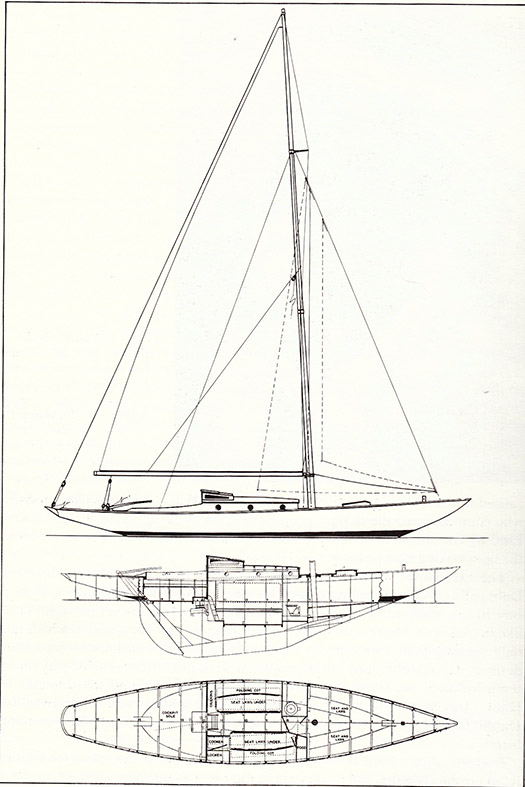 The Dublin Bay 24 might not be everyone's first choice for extended cruising, yet with Euphanzel Mickey d'Alton and Ninian Falkiner cruised to Norway, the Shetlands and St Kilda in 1956, and to the Faeroes in 1961. Both cruises were awarded the Irish Cruising Club premier trophy, the Faulkner Cup.
The Dublin Bay 24 might not be everyone's first choice for extended cruising, yet with Euphanzel Mickey d'Alton and Ninian Falkiner cruised to Norway, the Shetlands and St Kilda in 1956, and to the Faeroes in 1961. Both cruises were awarded the Irish Cruising Club premier trophy, the Faulkner Cup.
They'd come out of the south end of the Sound of Mull and were shaping their course towards the Sound of Jura as evening drew on, and as Oban was nearby, Michael suggested to Mickey that they might use Oban as an overnight anchorage. "I'd rather not" was the response, "I spent what seemed like a very long time in Oban on a training course during the war, and if I never see the place again it will be too soon".
With this award of the Legion d'Honneur, Mickey d'Alton will now be best known as an Irish hero of D-Day, which is perhaps as it should be. But the fact is that since the war ended, he has had an unrivalled sailing career – both inshore and offshore – of the highest achievements, while his life ashore has been one of abundant energy and many interests. Although a Chartered Quantity Surveyor, in his fifties he returned to college to study arbitration, and then went on to post graduate qualifications which have seen him negotiating and hearing cases at the highest international level.
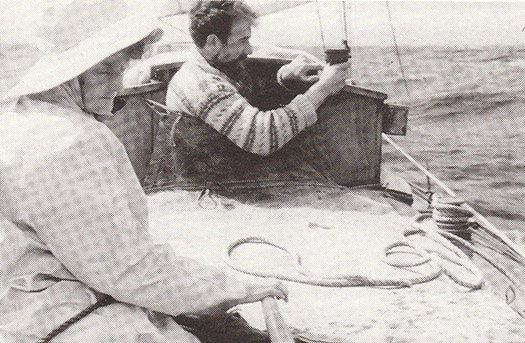 Mabel d'Alton at the helm as Michael O'Rahilly takes a bearing during the 1961 cruise to the Faeroes. Between them is the famous "D'Alton Cockpit Cover", which was fitted to Euphanzel on longer offshore passages as the Dublin Bay 24 did not have a self-draining cockpit. Photo: Michael d'Alton
Mabel d'Alton at the helm as Michael O'Rahilly takes a bearing during the 1961 cruise to the Faeroes. Between them is the famous "D'Alton Cockpit Cover", which was fitted to Euphanzel on longer offshore passages as the Dublin Bay 24 did not have a self-draining cockpit. Photo: Michael d'Alton
He married a kindred spirit in Mabel, and their two children Mark and Sonda bring the same lively intelligence to everything they do.
As to his sailing, although his proven success and perfectionism as a navigator in the era long before radio and electronics took over made him set the highest standards for his shipmates, he has always had the happy knack of teaming up with people whose abilities and resources neatly match his own skills, so much so that while he has owned a couple of boats, they have always been in partnership with kindred spirits.
His most renowned sailing achievements were as navigator and effectively sailing master with Ninian Falkiner, a pillar of the Dublin medical establishment who went on to become Commodore of the Royal Irish Yacht Club, with whom Mickey formed a very fruitful sailing partnership from 1944 until Ninian Falkiner's death in 1972.
Their best-known achievements were with the Dublin Bay 24 Euphanzel from 1948 until 1965. Gradually they built up their expectations with short cruises and offshore races, but in 1956 they hit the big time with a cruise from Dublin Bay through Scotland's Caledonian Canal to Norway, then across to the Shetland Islands following which – the weather being favourable – they simply sailed on across the open Atlantic in a sou'westerly direction for hundred of miles until they reached St Kilda, regarded as Ultima Thule in those days.
For this cruise, they were awarded the Irish Cruising Club's premier trophy, the Faulkner Cup. To put it in perspective, remember that as soon as Euphanzel got back to Dublin Bay, she returned to being a One Design boat in a Dun Laoghaire class raced regularly with the greatest possible vigour. Yet most summers they cruised as well, in 1961 going to the Faeroes with a special kayak-style cockpit cover developed by Mickey as the DB 24s didn't have a self-draining cockpit, and he reckoned they'd get their come-uppance one day. It duly happened on the way back – they were hit by a Force 9 but the d'Alton Cover worked a treat, whie their thoroughbred boat continued to make to windward in horrifying seas, with Mickey's navigation spot-on in almost zero visibility.
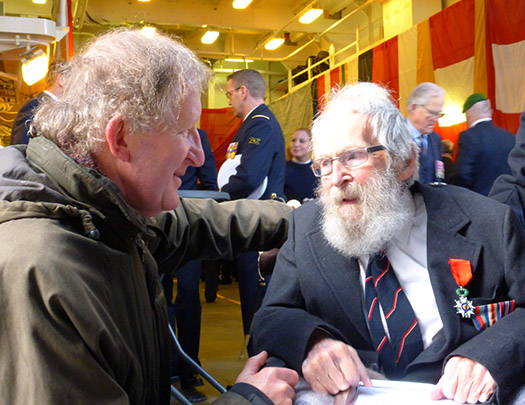 Shipmates re-united. James Nixon (left) was one of many sailing friends who went aboard the Somme in Dublin to congratulate Michael d'Alton on his Legion d'Honneur. In 1964 they sailed together round Ireland in Euphanzel, and subsequently went to the Faeroes in the Excalibur 36 Tir na nOg. Photo: W M Nixon
Shipmates re-united. James Nixon (left) was one of many sailing friends who went aboard the Somme in Dublin to congratulate Michael d'Alton on his Legion d'Honneur. In 1964 they sailed together round Ireland in Euphanzel, and subsequently went to the Faeroes in the Excalibur 36 Tir na nOg. Photo: W M Nixon
1964 saw a last hurrah with Euphanzel with a round Ireland cruise, then the following year Ninian Falkiner was one of those who went with the modernising of Dublin Bay sailing, as he bought a brand new all fibreglass van de Stadt-designed Excalibur 36 which he called Tir na nOg. The mixture of local and offshore racing and extensive cruising which had become established with Euphanzel was continued, but after five years NInian and Mickey felt they'd done their duty by glassfibre, and the last boat for the team was the 12-ton Nicholson designed timber sloop Felise, which in 1970 they cruised to the Lofoten Islands in northern Norway.
With Ninian's death in 1972, Mickey became involved in partnership with a 25ft Glen OD, while his most notable cruising achievement during the mid '70s was as navigator for Paul Campbell aboard the latter's 37ft Tyrrell-built yawl Verve, which in 1975 they sailed out to Rockall where, from a dinghy rowed by Mickey, crewman Willie Dick, who had extensive rock-climbing experience, became possibly the first person - certainly the first yachtsman - to land directly on that tricky bit of rock, as any previous known landings had been by helicopter.
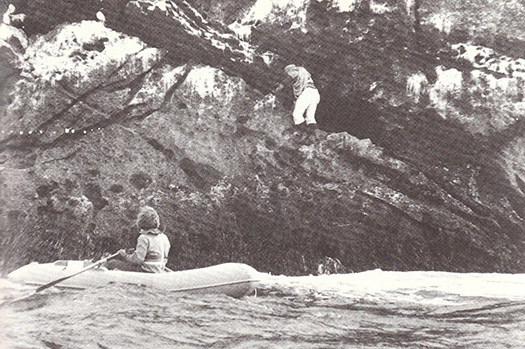 The Rockall landing in 1975 from Paul Campbell's Verve. Mickey d'Alton is manoeuvring the dinghy, while Willie Dick has just managed to grasp a handhold after jumping on to the rock face.
The Rockall landing in 1975 from Paul Campbell's Verve. Mickey d'Alton is manoeuvring the dinghy, while Willie Dick has just managed to grasp a handhold after jumping on to the rock face.
By this stage in life with his sixties approaching, Mickey d'Alton's sailing programme might have been expected to slacken. But war veterans cherish their freedom to go sailing as and when they please, and they cherish it far too much to think of easing off, let alone retiring.
So what is arguably the best part of Mickey d'Alton's sailing and cruising career was about to begin. He linked up with fellow senior sailors Franz Winkelmann and Leslie Latham, and they bought themselves a Ruffian 23 – Siamsa – which gave double value as she provided them with regular One Design racing in Dublin Bay, and thanks to modifications mostly made by Mickey – sometimes utilising unexpected items of equipment in unusual ways – she was turned into a very able little cruiser.
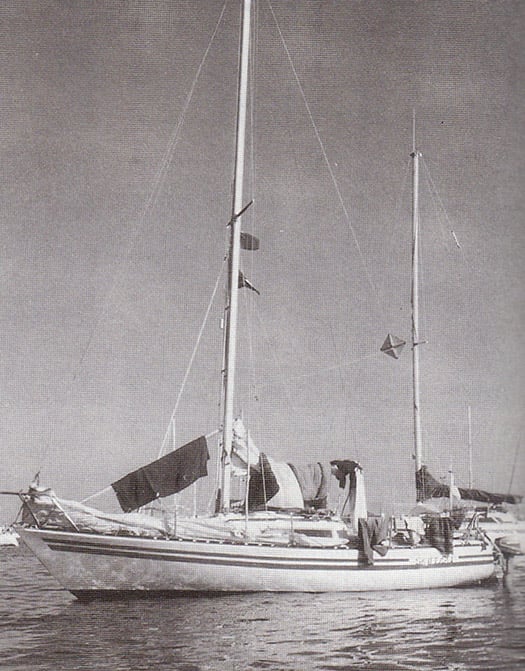
The Ruffian 23 Siamsa "airing out" during the 1997 cruise from Dublin Bay to the Isle of Scilly. Three very senior sailors managed to cruise thousands of miles in this very able if decidedly small boat.
And by heavens, how these three old guys cruised their little boat. It was all the more remarkable as Franz was all of 6ft 2ins tall, and more or less had to be folded in two if he was going to get below, while Leslie was so old his age was never mentioned. As for Mickey, his only concession to the passing years was that his vigorous hair and bushy beard were allowed even more freedom of movement and growth, and he looked like someone sent out from Central Casting to be the Old Man of the Sea.
The years may have been passing, but the enthusiasm for sailing never dimmed. Of their many cruises to many places, one of my favourites has to be the cruise to St Kilda in 1983. Siamsa's only auxiliary engine was an outboard so small it could only push them in and out of port in a calm, otherwise they were sail only, so in getting to St Kilda they dealt with headwinds simply by keeping sailing, and kedging in the nearest handy roadstead when the tide turned against them while beating through the Irish Sea and North Channel.
Maintaining a viable way of life in a 23 footer without standing headroom would have been a challenge to most sailors, but the crew of Siamsa just kept plodding along, they'd experienced it before, they knew they'd get there in due course, and meanwhile weren't they sailing and having a very satisfying time?
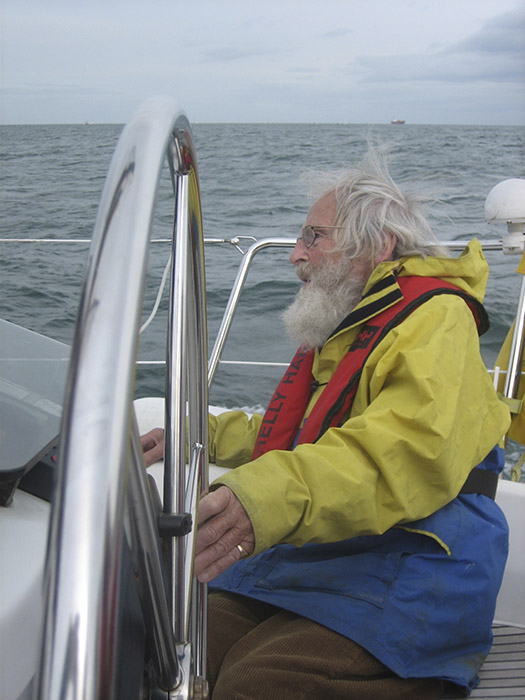 Still at it. Mickey d'Alton at the helm of John Latham's Beneteau Oceanis 311 Seasaw. Photo: Sonda d'Alton
Still at it. Mickey d'Alton at the helm of John Latham's Beneteau Oceanis 311 Seasaw. Photo: Sonda d'Alton
This remarkable partnership afloat lasted for well nigh fifteen years. In time Leslie passed on, then Franz died, yet although Siamsa was sold, Mickey continued sailing until quite recently with John Latham, Leslie's son, on his Beneteau Oceanis 311 Seasaw, while his love remains undimmed for the remote places best visited by cruising boats, and particularly the west of Ireland,
Until this week, Mickey d'Alton was best known as a sailing man, and in the world of sailing it was in the inner circles of cruising that he was most highly regarded. Over the years, his awards have included the Faulkner Cup of the Irish Cruising Club in 1956 and 1961, the ICC's Round Ireland Cup in 1964, and the same club's Wybrants Cup in 1983 and 1986, its Fingal Cup in 1990, and the Fortnight Cup – for a cruise to the Isles of Scilly in the little Siamsa – in 1997.
In addition, there would be a host of trophies from offshore races of varying lengths, and from inshore racing in Dublin Bay. And now, many years after receiving his medals won and presented during wartime, he is Legion d'Honneur and USV Distinguished Service Award. A great man.
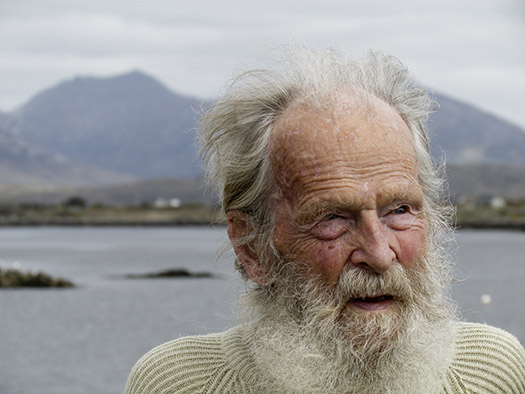 Man of the west. Mickey d'Alton recently photographed in Roundstone in his beloved West of Ireland. Photo: Sonda d'Alton
Man of the west. Mickey d'Alton recently photographed in Roundstone in his beloved West of Ireland. Photo: Sonda d'Alton
Antrim Sping Cleaners Find Riverbed Bomb
Inland Waterways Spring cleaners at Sixmilewater River in Co Antrim got the surprise of their lives last weekend when a Second World War mortar shell was discovered in the riverbed.
Volunteers for Big Spring Clean Week had already picked it up from the water, thinking it at first to be a piece of metal piping, before they realised what they really had on their hands.
The Belfast Telegraph reports that the shocking find sparked a security alert for most of the day. The nearby Dublin Road was closed while army bomb disposal experts removed the device for examination.
The bomb was described a being 20 inches long, "torpedo-shaped" and "pale green".
It joined a list of random items including a bicycle, three scooters, golf clubs and a taxi sign that were retrieved from a single 100m stretch of the river near the Antrim Forum.
Former WW II Oil-Tanker Lays Cables Across Cork Harbour
To read further information about the cable installation project which is listed on the Port of Cork Company website under Notice to Mariners (No. 6 of 2011) click here.
The odd appearance of the barge masks a colourful and chequered career, as only a remnant of the original vessel survives (see photo). Only the forward section and bow (90m long X 20m beam) remain after the partial scrapping of the former oil tanker, Esso København, which took place nearly fifty years ago.
She was launched in 1930 as the MS Peter Hurll by the Palmers Shipbuilding and Iron Company Ltd (Yard/Hull no. 479) at Hebburn-on-Tyne, England. Measuring 11,952grt the tanker was commissioned for Baltisch-Amerik Petroleum Import G.m.b.H. (Waried Tankschiff Rhed.) of Danzig. For further details click here.
The vessel's profile was typical of the era, with a 'two-island' arrangement where the bridge superstructure is sited amidships and separated from the crew's accommodation quarters located aft on the poop deck at the stern.
At 452-foot long, the 17,585dwt vessel had a cargo carrying capacity of 138,108 barrels, which had an assigned pumping rate of 4,000 barrels an hour. The twin-screw diesel powered vessel had 5,300 brake horsepower engines that gave a speed of 12.3 knots.
In 1935 the vessel was sold to the Panama Transport Co. of Panama. While en route to Aruba, with an American crew, war was declared in Europe on September 3, 1939. At the Caribbean island's port of Las Piedras the Peter Hurll loaded her first war-time cargo of 106,514 barrels of fuel and crude oils bound for Everett, Mass.
Throughout the war years the Peter Hurll was crewed at various times between Americans and Danes. To read in greater detail the career history of the vessel and an account of the attempted U-Boat attack on the Peter Hurll click here. The tanker had several sisters, the F. H. Bedford Jr, J. H. Senior, J.A. Mowinckel and The Heinrich v. Riedemann which was lost on April 16, 1942.
Only a few months after the war in February 1946, the Peter Hurll bunkered the Queen Mary, which was moored alongside Pier 90 on the North River, New York. In less than 10 hours the vessel tranferred 27,797 barrels of fuel in a direct tanker-to-ship delivery of fuel oil. The famous 80,000 tonnes Cunard liner which like the tanker, was also built in 1930, had been recently re-converted from a troopship to her peacetime role as a passenger-liner.
In 1967 the liner retired and the vessel is moored at Long Beach, California, as a static hotel, restaurant and museum (see www.queenmary.com).
Two years later the Peter Hurll changed ownership to Det Danske Petroleums A/S of Copenhagen but later under the control of Dansk Esso A/S was renamed Esso København (see link) and the vessel was enlarged to a tonnage of 12,043grt.
In 1952, the vessel was taken to Odense, Denmark by H. J. Hansen, where the vessel was partially broken-up. The remaining fore-end survived and was rebuilt as a cable / pipe laying barge in 1963 (click here). The structure which essentially is a barge was named Henry P Lading for new owners, Nordisk Kabel og Traadfabrikker A/S, Copenhagen.
At one stage the barge was renamed "Nkt Cables a/S" but in 2002 the barge was sold to Jydsk Dykkerfirma ApS, now named JD Contractor A/S. The company (click here) is the largest underwater contractor in Denmark, providing diving assignments and the laying and embedding of submarine cables and pipelines worldwide.
Only late last year, scuba-divers found a fully intact World War I U-Boat on the seabed just outside Cork harbour. To read more about the U-Boat which sank some 93 years ago and photos click here.

































































